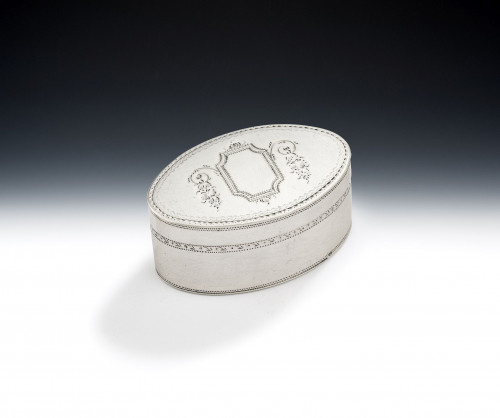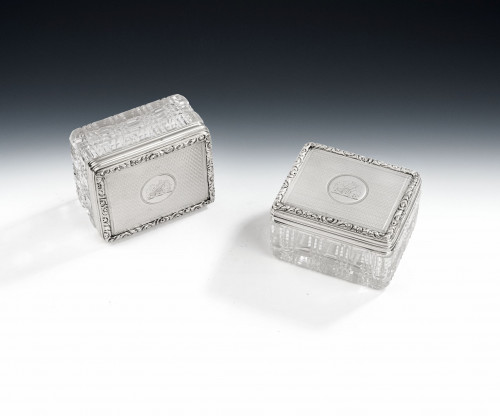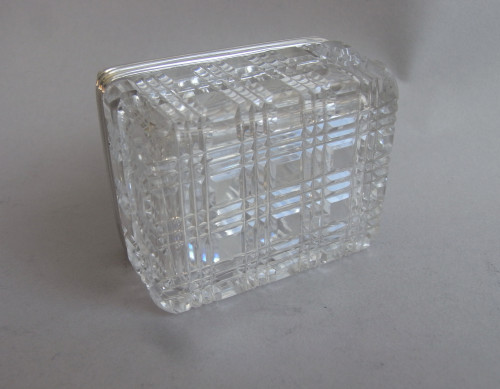An exceptional pair of George III Military Presentation Goblets made in London in 1803 by George Smith & Thomas Hayter.
An exceptional pair of George III Military Presentation Goblets made in London in 1803 by George Smith & Thomas Hayter.
375388
The Goblets stand on a circular pedestal, stepped, foot decorated with reeding and an engraved band of foliate scrolls on a scratch engraved ground. The foot ascends to a vase shaped bowl with deeply gilded interior displaying a beautiful bright cut engraved rim of waves, scrolls, floral sprays and flower heads in ovals. The front of the bowl is engraved with a contemporary Armorial with Crest above and the Motto “ Mea Gloria Fides” engraved on a banner below. This is flanked by one of the finest military cartouches we have seen including flags, battle drums, axes, spears and canons. This is all surrounded by a herring bone frame. The reverse is engraved with the following contemporary inscription surrounded by the same herring bone frame as seen on the front:
The Gift of the
Non Commissioned Officers
and Privates of the
Stockport Loyal Volunteers
To MAJOR WATSON
Their Commanding Officer for his
Zeal and Abilities in discharging
the several duties of his Station
for the space of 8 years
1803.
The Goblets are in quite excellent condition and are very well marked in the foot. They are of the finest quality and a very good weight. They were presented on the dissolution of the regiment. The Goblets are accompanied with an engraved portrait of Holland Watson “presented to each individual of the Stockport Volunteers as a Testimony of approbation for discipline well observed, and of grateful return of many proofs of personal attachment”.
The will of Holland Watson (1751-1829) left this pair of goblets to his eldest son Hewett Cottrell Watson (1804-1881)- part of 'the large silver cup presented to me by the Officers of the Stockport Volunteer Corps formerly commanded by me and the four silver Goblet Cups presented to me by the non-commissioned Officers and Privates of the said Volunteer Corps'.
Holland Watson was born in Swinton (Lancashire) in 1751 as the first child of James Watson and Judith Holland and was apprenticed to John Howart, an attorney of Soyland (Yorkshire) in 1769. On 19th April 1790 Watson married Margaret Ware in Stockport but sadly she died on the 9th of July that year. On 2nd April 1794 he married for the second time to Harriet Powell, daughter of Richard Powell of Brandlesholme Hall, in Manchester Cathedral, and the couple had seven daughters and three sons.
In 1792 Holland Watson was clerk to Stockport's Rector Magistrate. This year also saw the foundation of the Friends of Universal Peace and the Rights of Man by John Andrew and Nathaniel Hibbert. This was a radical society in sympathy with the ideals of Thomas Paine and the French Revolution and when the first meeting was advertised on the 11th September Watson wrote a public letter denouncing it in the Evening Mail. This led to a pamphlet war but by December Watson had escalated his opposition to the local radicals and founded the Stockport Reeves Association, an anti-jacobin association and in 1794 he became commandant of the newly formed Stockport Volunteers. The volunteer regiments allowed ambitious local men to publically demonstrate their loyalty to the establishment and participate in parades and national celebrations.
The Stockport Volunteers had an elaborate uniform, the rules and regulations stipulating “That the Uniform Coat shall be blue cloth, the cape, cuffs and facings of scarlet cloth edged with white, and to have wings and shoulder straps ornamented with gold lace and fringe…. The Waistcoat and Breeches to be white cassimere or cloth, the buttons to be gilt, and to have the letters S.V stamped on them.” The Volunteers were eulogised in a poem by Robert Farren Cheetham, a poet from Stockport with a passion for the defence of Church and King, in his Poems of 1798 . He described them as being “with patriot zeal inspired, A numerous band, that claim the meed of praise, Their souls with true heroic ardour fired, Their glorious deeds shall live, till time itself decays”. The Regiment was in existence until 1802, when war with France ceased on the signing of the Peace of Amiens, and, although the hostilities were resumed in 1803, the Stockport Volunteers were not re-established.
Hewett Cottrell Watson, who inherited these goblets, lived to the age of 77, but having initially followed his father into the legal profession changed his mind and studied Medicine and Natural History at Edinburgh University from 1828-1832. There he became interested in Phrenology as well as becoming a noted botanist. He edited the Phrenological Journal from 1837-1840 and the London Catalogue of British Plants from 1844-1874. The Watsonian Vice-counties, small areas used for biological recording, are still in use today. In 1836 Watson speculated on the existence of the two hemispheres of the brain (eight years before Arthur Ladbroke Wigan published his influential The Duality of the Mind) and in 1856 he was invited to discuss evolutionary theory with Joseph Hooker and Charles Darwin (with whom he had a regular correspondence) because he was too busy and did not wish to travel from Thames Ditton to Downe(30 miles away). Nonetheless Watson was prominent among the acknowledged experts in Darwin's Origin of Species (1859) and was among the first to write and congratulate Darwin on his achievement.
Thomas Hayter was apprenticed to George Smith from 4th December, 1782 He was free in February 1790 and his first mark was entered in partnership with George Smith II in 1792, operating from workshops at 4, Huggin Lane, Wood Street. By 1805 the partnership had been dissolved and he was working alone.
Height: 7.1 inches, 17.75 cm.
Diameter of the bowl: 4.1 inches, 10.25 cm.
Weight: 25 oz, the pair.
RELATED ITEMS



































